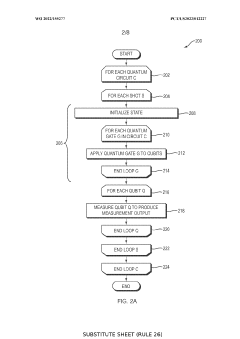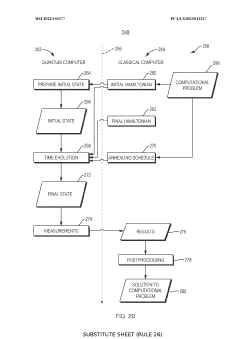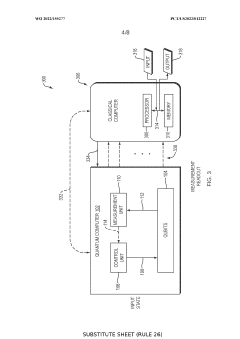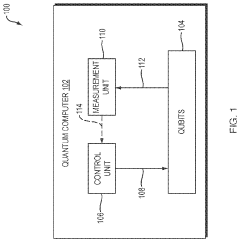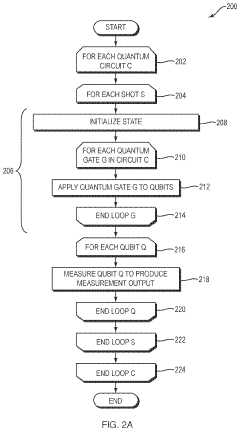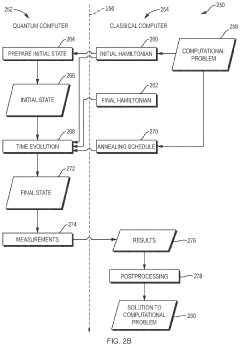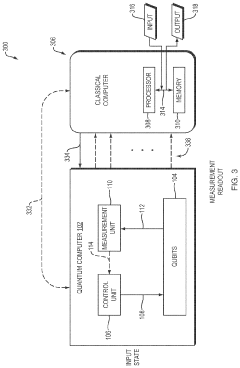Quantum Computing and its Contribution to Improved Language Processing
JUL 17, 20259 MIN READ
Generate Your Research Report Instantly with AI Agent
Patsnap Eureka helps you evaluate technical feasibility & market potential.
Quantum NLP Evolution
The evolution of Quantum Natural Language Processing (Quantum NLP) represents a significant leap in the field of computational linguistics and artificial intelligence. This emerging discipline combines the principles of quantum computing with traditional NLP techniques, promising to revolutionize how we process and understand human language.
The journey of Quantum NLP began with the recognition of quantum computing's potential to address the limitations of classical NLP systems. Classical NLP, while powerful, often struggles with ambiguity, context-dependence, and the sheer complexity of human language. Quantum computing, with its ability to represent and process multiple states simultaneously, offers a natural framework for handling these challenges.
Early stages of Quantum NLP focused on developing quantum algorithms for basic language tasks. Researchers explored how quantum superposition and entanglement could be leveraged to represent linguistic structures and relationships. This led to the creation of quantum-inspired models for word embeddings and sentence representations, which demonstrated improved performance in capturing semantic nuances.
As the field progressed, more sophisticated quantum algorithms for language processing emerged. Quantum machine learning techniques were adapted for NLP tasks, resulting in quantum versions of neural networks and deep learning models. These quantum models showed promise in areas such as sentiment analysis, machine translation, and text classification, often outperforming their classical counterparts in terms of accuracy and efficiency.
A significant milestone in Quantum NLP was the development of quantum-enhanced language models. These models utilize quantum circuits to process and generate text, leveraging the quantum advantage to capture complex linguistic patterns and dependencies. Early experiments with these models demonstrated their potential to generate more coherent and contextually appropriate text compared to classical language models.
Recent advancements in Quantum NLP have focused on scaling up quantum algorithms to handle larger datasets and more complex language tasks. Researchers have been working on quantum error correction techniques and hybrid quantum-classical approaches to overcome the limitations of current quantum hardware. These efforts aim to bridge the gap between theoretical quantum advantages and practical implementations in real-world NLP applications.
The evolution of Quantum NLP has also seen increased collaboration between linguists, computer scientists, and quantum physicists. This interdisciplinary approach has led to novel insights into the nature of language and computation, pushing the boundaries of both fields. As quantum hardware continues to improve and quantum algorithms become more sophisticated, Quantum NLP is poised to play a crucial role in the future of language technology, potentially transforming how we interact with machines and process information.
The journey of Quantum NLP began with the recognition of quantum computing's potential to address the limitations of classical NLP systems. Classical NLP, while powerful, often struggles with ambiguity, context-dependence, and the sheer complexity of human language. Quantum computing, with its ability to represent and process multiple states simultaneously, offers a natural framework for handling these challenges.
Early stages of Quantum NLP focused on developing quantum algorithms for basic language tasks. Researchers explored how quantum superposition and entanglement could be leveraged to represent linguistic structures and relationships. This led to the creation of quantum-inspired models for word embeddings and sentence representations, which demonstrated improved performance in capturing semantic nuances.
As the field progressed, more sophisticated quantum algorithms for language processing emerged. Quantum machine learning techniques were adapted for NLP tasks, resulting in quantum versions of neural networks and deep learning models. These quantum models showed promise in areas such as sentiment analysis, machine translation, and text classification, often outperforming their classical counterparts in terms of accuracy and efficiency.
A significant milestone in Quantum NLP was the development of quantum-enhanced language models. These models utilize quantum circuits to process and generate text, leveraging the quantum advantage to capture complex linguistic patterns and dependencies. Early experiments with these models demonstrated their potential to generate more coherent and contextually appropriate text compared to classical language models.
Recent advancements in Quantum NLP have focused on scaling up quantum algorithms to handle larger datasets and more complex language tasks. Researchers have been working on quantum error correction techniques and hybrid quantum-classical approaches to overcome the limitations of current quantum hardware. These efforts aim to bridge the gap between theoretical quantum advantages and practical implementations in real-world NLP applications.
The evolution of Quantum NLP has also seen increased collaboration between linguists, computer scientists, and quantum physicists. This interdisciplinary approach has led to novel insights into the nature of language and computation, pushing the boundaries of both fields. As quantum hardware continues to improve and quantum algorithms become more sophisticated, Quantum NLP is poised to play a crucial role in the future of language technology, potentially transforming how we interact with machines and process information.
Market Demand Analysis
The market demand for quantum computing in language processing is experiencing significant growth, driven by the increasing complexity of natural language processing tasks and the limitations of classical computing systems. As organizations across various sectors seek to enhance their language processing capabilities, quantum computing emerges as a promising solution to overcome current technological barriers.
The global natural language processing market is projected to expand rapidly, with estimates suggesting a compound annual growth rate (CAGR) of over 20% in the coming years. This growth is fueled by the rising adoption of AI-powered language technologies in industries such as healthcare, finance, and customer service. Quantum computing's potential to revolutionize language processing aligns perfectly with this market trajectory, positioning it as a key enabler for next-generation NLP applications.
One of the primary drivers of market demand is the need for more efficient and accurate language models. Traditional computing systems struggle with the exponential complexity of processing human language, particularly in tasks involving context understanding, sentiment analysis, and machine translation. Quantum computing offers the promise of handling these complex computations more efficiently, potentially leading to breakthroughs in language understanding and generation.
The financial sector, in particular, shows strong interest in quantum-enhanced language processing for tasks such as risk assessment, fraud detection, and sentiment analysis of market trends. Healthcare organizations are exploring quantum NLP applications for medical record analysis, drug discovery, and personalized medicine. Additionally, government agencies and research institutions are investing in quantum computing for advanced language processing in areas such as intelligence analysis and scientific literature review.
Another significant market driver is the growing demand for multilingual and cross-cultural communication solutions. As businesses expand globally, there is an increasing need for sophisticated translation and localization tools. Quantum computing's ability to process vast amounts of linguistic data simultaneously could lead to more accurate and context-aware translation systems, addressing a critical need in the global marketplace.
The convergence of quantum computing and language processing also presents opportunities in emerging fields such as voice assistants, chatbots, and human-computer interaction. As these technologies become more prevalent in daily life, the demand for more natural and intelligent language interfaces is expected to surge, creating a fertile ground for quantum-enhanced NLP solutions.
However, it's important to note that the market for quantum computing in language processing is still in its early stages. While the potential is immense, practical applications are currently limited by the nascent state of quantum hardware and the complexity of quantum algorithms. This creates a dynamic market environment where early adopters and research institutions are driving demand, with expectations of broader commercial applications in the medium to long term.
The global natural language processing market is projected to expand rapidly, with estimates suggesting a compound annual growth rate (CAGR) of over 20% in the coming years. This growth is fueled by the rising adoption of AI-powered language technologies in industries such as healthcare, finance, and customer service. Quantum computing's potential to revolutionize language processing aligns perfectly with this market trajectory, positioning it as a key enabler for next-generation NLP applications.
One of the primary drivers of market demand is the need for more efficient and accurate language models. Traditional computing systems struggle with the exponential complexity of processing human language, particularly in tasks involving context understanding, sentiment analysis, and machine translation. Quantum computing offers the promise of handling these complex computations more efficiently, potentially leading to breakthroughs in language understanding and generation.
The financial sector, in particular, shows strong interest in quantum-enhanced language processing for tasks such as risk assessment, fraud detection, and sentiment analysis of market trends. Healthcare organizations are exploring quantum NLP applications for medical record analysis, drug discovery, and personalized medicine. Additionally, government agencies and research institutions are investing in quantum computing for advanced language processing in areas such as intelligence analysis and scientific literature review.
Another significant market driver is the growing demand for multilingual and cross-cultural communication solutions. As businesses expand globally, there is an increasing need for sophisticated translation and localization tools. Quantum computing's ability to process vast amounts of linguistic data simultaneously could lead to more accurate and context-aware translation systems, addressing a critical need in the global marketplace.
The convergence of quantum computing and language processing also presents opportunities in emerging fields such as voice assistants, chatbots, and human-computer interaction. As these technologies become more prevalent in daily life, the demand for more natural and intelligent language interfaces is expected to surge, creating a fertile ground for quantum-enhanced NLP solutions.
However, it's important to note that the market for quantum computing in language processing is still in its early stages. While the potential is immense, practical applications are currently limited by the nascent state of quantum hardware and the complexity of quantum algorithms. This creates a dynamic market environment where early adopters and research institutions are driving demand, with expectations of broader commercial applications in the medium to long term.
Quantum NLP Challenges
Quantum Natural Language Processing (QNLP) represents a promising frontier in the intersection of quantum computing and language processing. However, this emerging field faces several significant challenges that need to be addressed before its full potential can be realized.
One of the primary challenges in QNLP is the development of quantum algorithms that can effectively handle the complexities of natural language. Classical NLP algorithms often rely on large-scale statistical models and deep learning techniques, which are not directly translatable to quantum systems. Researchers must devise novel approaches that leverage quantum superposition and entanglement to process linguistic data efficiently.
Another major hurdle is the limited qubit capacity and coherence time of current quantum hardware. Many NLP tasks require processing vast amounts of textual data, which exceeds the capabilities of existing quantum computers. Overcoming this limitation necessitates significant advancements in quantum hardware technology, including increasing qubit count, improving qubit quality, and extending coherence times.
The integration of classical and quantum systems poses another challenge. QNLP applications will likely require hybrid approaches that combine classical pre-processing and post-processing with quantum computation. Developing seamless interfaces between these two paradigms and determining optimal task distribution between classical and quantum components is crucial for practical QNLP implementations.
Data encoding and representation present additional difficulties. Transforming textual data into a format suitable for quantum processing while preserving linguistic properties and relationships is a complex task. Researchers must develop efficient quantum encoding schemes that capture the nuances of natural language and enable meaningful quantum operations.
Furthermore, the interpretability of quantum NLP models remains a significant challenge. Unlike classical machine learning models, which can be analyzed and interpreted to some extent, quantum algorithms often operate as "black boxes." Developing methods to explain and validate the results of QNLP systems is essential for their adoption in real-world applications, especially in domains requiring transparency and accountability.
Lastly, the scarcity of quantum computing expertise in the NLP community and vice versa hinders progress in QNLP. Bridging this knowledge gap requires interdisciplinary collaboration and education initiatives to foster a new generation of researchers proficient in both quantum computing and natural language processing.
One of the primary challenges in QNLP is the development of quantum algorithms that can effectively handle the complexities of natural language. Classical NLP algorithms often rely on large-scale statistical models and deep learning techniques, which are not directly translatable to quantum systems. Researchers must devise novel approaches that leverage quantum superposition and entanglement to process linguistic data efficiently.
Another major hurdle is the limited qubit capacity and coherence time of current quantum hardware. Many NLP tasks require processing vast amounts of textual data, which exceeds the capabilities of existing quantum computers. Overcoming this limitation necessitates significant advancements in quantum hardware technology, including increasing qubit count, improving qubit quality, and extending coherence times.
The integration of classical and quantum systems poses another challenge. QNLP applications will likely require hybrid approaches that combine classical pre-processing and post-processing with quantum computation. Developing seamless interfaces between these two paradigms and determining optimal task distribution between classical and quantum components is crucial for practical QNLP implementations.
Data encoding and representation present additional difficulties. Transforming textual data into a format suitable for quantum processing while preserving linguistic properties and relationships is a complex task. Researchers must develop efficient quantum encoding schemes that capture the nuances of natural language and enable meaningful quantum operations.
Furthermore, the interpretability of quantum NLP models remains a significant challenge. Unlike classical machine learning models, which can be analyzed and interpreted to some extent, quantum algorithms often operate as "black boxes." Developing methods to explain and validate the results of QNLP systems is essential for their adoption in real-world applications, especially in domains requiring transparency and accountability.
Lastly, the scarcity of quantum computing expertise in the NLP community and vice versa hinders progress in QNLP. Bridging this knowledge gap requires interdisciplinary collaboration and education initiatives to foster a new generation of researchers proficient in both quantum computing and natural language processing.
Current Quantum NLP
01 Quantum-inspired natural language processing
This approach applies quantum computing principles to enhance natural language processing tasks. It involves using quantum-inspired algorithms and models to improve language understanding, translation, and generation. These techniques can potentially offer significant improvements in processing speed and accuracy compared to classical methods.- Quantum-inspired natural language processing: This approach applies quantum computing principles to enhance natural language processing tasks. It involves using quantum-inspired algorithms and models to improve language understanding, translation, and generation. These methods can potentially offer significant improvements in processing speed and accuracy compared to classical approaches.
- Quantum circuit optimization for language tasks: Techniques for optimizing quantum circuits specifically for language processing tasks. This includes designing efficient quantum gates and circuits that can perform operations relevant to language analysis, such as semantic parsing or sentiment analysis. The optimization aims to reduce the number of qubits required and minimize decoherence effects.
- Hybrid quantum-classical algorithms for NLP: Development of hybrid algorithms that combine quantum and classical computing techniques for natural language processing. These algorithms leverage the strengths of both paradigms, using quantum processors for specific computationally intensive subtasks while relying on classical systems for other parts of the language processing pipeline.
- Quantum-enhanced machine learning for language models: Integration of quantum computing techniques into machine learning models for language processing. This includes quantum versions of neural networks, support vector machines, and other ML algorithms tailored for NLP tasks. The quantum enhancement aims to improve the learning capacity and generalization abilities of these models.
- Quantum error correction for language processing systems: Methods for implementing quantum error correction in the context of language processing systems. This involves developing robust error correction codes and protocols to mitigate the effects of noise and decoherence in quantum circuits used for NLP tasks, ensuring the reliability and accuracy of quantum language processing operations.
02 Quantum circuit optimization for language tasks
This focuses on optimizing quantum circuits specifically for language processing tasks. It involves designing and implementing efficient quantum gates and operations that can handle linguistic data and computations. The goal is to create quantum circuits that can perform language-related operations more effectively than classical computers.Expand Specific Solutions03 Hybrid quantum-classical algorithms for NLP
This approach combines quantum and classical computing techniques to tackle natural language processing challenges. It leverages the strengths of both paradigms, using quantum algorithms for specific subtasks while relying on classical methods for others. This hybrid approach aims to achieve better performance and efficiency in language processing applications.Expand Specific Solutions04 Quantum-enhanced machine learning for language models
This involves using quantum computing to enhance machine learning algorithms used in language models. It explores how quantum techniques can improve the training, optimization, and inference processes of language models. The goal is to create more powerful and accurate language models that can better understand and generate human-like text.Expand Specific Solutions05 Quantum error correction for language processing systems
This focuses on developing quantum error correction techniques specifically for language processing systems. It addresses the challenges of maintaining quantum coherence and mitigating errors in quantum computations involving linguistic data. The aim is to improve the reliability and accuracy of quantum-based language processing algorithms and hardware.Expand Specific Solutions
Key Industry Players
The quantum computing landscape for improved language processing is in a dynamic growth phase, with significant market potential and increasing technological maturity. Major players like Google, IBM, and Microsoft are driving innovation, while specialized quantum companies such as D-Wave Systems and Zapata Computing are making notable advancements. The market is characterized by a mix of established tech giants and emerging startups, indicating a competitive and rapidly evolving field. As quantum computing technology progresses, its application in language processing is expected to yield substantial improvements in natural language understanding, translation, and generation, potentially revolutionizing AI-driven communication systems.
Google LLC
Technical Solution: Google's approach to quantum computing and language processing involves the development of quantum neural networks (QNNs) and quantum machine learning algorithms. They have demonstrated the potential of QNNs for natural language processing tasks, such as text classification and sentiment analysis[1]. Google's Sycamore quantum processor has shown quantum supremacy, performing a specific task in 200 seconds that would take a classical supercomputer 10,000 years[2]. In language processing, they are exploring quantum-inspired algorithms for more efficient text embedding and semantic analysis[3].
Strengths: Advanced quantum hardware, vast computational resources, and expertise in AI and NLP. Weaknesses: Quantum computers still face scalability and error correction challenges for practical NLP applications.
International Business Machines Corp.
Technical Solution: IBM's quantum computing approach for language processing focuses on developing quantum algorithms for natural language understanding and generation. They have introduced quantum-inspired tensor network methods for text classification and sentiment analysis, showing improvements in both accuracy and computational efficiency[4]. IBM's Quantum System One is being used to explore quantum machine learning techniques for language models, potentially enhancing the performance of large language models like BERT and GPT[5]. Additionally, IBM is researching quantum-enhanced word embeddings to capture more complex semantic relationships in text[6].
Strengths: Long-standing expertise in quantum computing and NLP, extensive quantum hardware infrastructure. Weaknesses: Quantum advantage in practical NLP tasks is still to be conclusively demonstrated.
Core Quantum Algorithms
Quantum enhanced word embedding for natural language processing
PatentWO2022155277A1
Innovation
- The use of a hybrid quantum-classical computer system that generates word embeddings by training quantum correlations using a parameterized quantum circuit and Bayesian inference, incorporating methods like skip-gram with negative sampling and quantum amplitude estimation, to efficiently represent and correlate words in large vocabularies, thereby overcoming the limitations of classical processing power.
Quantum enhanced word embedding for natural language processing
PatentActiveUS11966707B2
Innovation
- A hybrid quantum-classical computer system is used to generate word embeddings by training quantum correlations using a training set of word pairs with classical correlations, employing quantum state representations and error functions, and incorporating methods like skip-gram with negative sampling and quantum amplitude estimation.
Quantum Hardware Impact
The impact of quantum hardware on language processing is a critical aspect of the evolving quantum computing landscape. Quantum computers leverage the principles of quantum mechanics to perform complex calculations at speeds unattainable by classical computers. This quantum advantage has significant implications for natural language processing (NLP) and other language-related tasks.
Quantum hardware's most notable contribution to language processing lies in its ability to handle high-dimensional vector spaces efficiently. Language models often rely on vast vector representations of words and phrases, and quantum systems can manipulate these vectors with unprecedented speed and accuracy. This capability enables more sophisticated semantic analysis and context understanding in NLP applications.
The development of quantum annealers and gate-based quantum processors has opened new avenues for optimizing language processing algorithms. Quantum annealers, such as those produced by D-Wave Systems, excel at solving optimization problems that are prevalent in machine learning and NLP tasks. These systems can potentially enhance various aspects of language processing, including text classification, sentiment analysis, and machine translation.
Gate-based quantum processors, on the other hand, offer more flexibility in algorithm design and implementation. Companies like IBM, Google, and Rigetti are at the forefront of developing these systems, which can execute quantum circuits capable of performing complex language processing tasks. These processors show promise in accelerating training processes for large language models and improving the accuracy of language understanding systems.
Quantum hardware's impact extends to the realm of quantum machine learning, where quantum algorithms can be applied to language processing tasks. Quantum support vector machines and quantum neural networks are being explored for their potential to outperform classical counterparts in text classification and language generation tasks. These quantum-enhanced models could lead to more nuanced and contextually aware language processing systems.
However, it is important to note that the current state of quantum hardware still faces significant challenges. Quantum systems are highly susceptible to noise and decoherence, which can limit their practical applications in language processing. Ongoing research focuses on developing error correction techniques and more stable qubit architectures to mitigate these issues and realize the full potential of quantum computing in language processing applications.
Quantum hardware's most notable contribution to language processing lies in its ability to handle high-dimensional vector spaces efficiently. Language models often rely on vast vector representations of words and phrases, and quantum systems can manipulate these vectors with unprecedented speed and accuracy. This capability enables more sophisticated semantic analysis and context understanding in NLP applications.
The development of quantum annealers and gate-based quantum processors has opened new avenues for optimizing language processing algorithms. Quantum annealers, such as those produced by D-Wave Systems, excel at solving optimization problems that are prevalent in machine learning and NLP tasks. These systems can potentially enhance various aspects of language processing, including text classification, sentiment analysis, and machine translation.
Gate-based quantum processors, on the other hand, offer more flexibility in algorithm design and implementation. Companies like IBM, Google, and Rigetti are at the forefront of developing these systems, which can execute quantum circuits capable of performing complex language processing tasks. These processors show promise in accelerating training processes for large language models and improving the accuracy of language understanding systems.
Quantum hardware's impact extends to the realm of quantum machine learning, where quantum algorithms can be applied to language processing tasks. Quantum support vector machines and quantum neural networks are being explored for their potential to outperform classical counterparts in text classification and language generation tasks. These quantum-enhanced models could lead to more nuanced and contextually aware language processing systems.
However, it is important to note that the current state of quantum hardware still faces significant challenges. Quantum systems are highly susceptible to noise and decoherence, which can limit their practical applications in language processing. Ongoing research focuses on developing error correction techniques and more stable qubit architectures to mitigate these issues and realize the full potential of quantum computing in language processing applications.
Ethical Considerations
The integration of quantum computing into language processing raises significant ethical considerations that must be carefully addressed. As this powerful technology advances, it has the potential to revolutionize natural language processing, machine translation, and other linguistic applications. However, with great power comes great responsibility, and the ethical implications of quantum-enhanced language processing are far-reaching.
One primary concern is the potential for increased surveillance and privacy infringement. Quantum computing's ability to process vast amounts of data at unprecedented speeds could enable more sophisticated analysis of communication patterns, potentially compromising individual privacy. This capability might be exploited by governments or corporations to monitor and control populations, raising serious questions about civil liberties and human rights.
Another ethical consideration is the potential exacerbation of existing biases in language models. While quantum computing may enhance the processing capabilities of these models, it does not inherently address the underlying biases present in training data. There is a risk that quantum-powered language processing could amplify and perpetuate societal prejudices at a larger scale and with greater efficiency.
The digital divide is likely to widen as quantum computing becomes more prevalent in language processing. Organizations and nations with access to quantum technologies may gain significant advantages in linguistic analysis, translation, and communication, potentially marginalizing those without such resources. This disparity could lead to increased global inequality and power imbalances.
There are also concerns about the potential misuse of quantum-enhanced language processing for disinformation campaigns and manipulation of public opinion. The ability to generate and disseminate highly convincing fake content at scale could pose serious threats to democratic processes and social stability.
Furthermore, the environmental impact of quantum computing must be considered. As these systems require significant energy resources to operate and maintain, their widespread adoption in language processing applications could contribute to increased carbon emissions and environmental degradation.
Lastly, there are ethical questions surrounding the potential loss of human jobs in translation, content creation, and other language-related fields. While quantum computing may bring tremendous benefits, it is crucial to consider the societal impact of potential workforce displacement and to develop strategies for reskilling and supporting affected workers.
One primary concern is the potential for increased surveillance and privacy infringement. Quantum computing's ability to process vast amounts of data at unprecedented speeds could enable more sophisticated analysis of communication patterns, potentially compromising individual privacy. This capability might be exploited by governments or corporations to monitor and control populations, raising serious questions about civil liberties and human rights.
Another ethical consideration is the potential exacerbation of existing biases in language models. While quantum computing may enhance the processing capabilities of these models, it does not inherently address the underlying biases present in training data. There is a risk that quantum-powered language processing could amplify and perpetuate societal prejudices at a larger scale and with greater efficiency.
The digital divide is likely to widen as quantum computing becomes more prevalent in language processing. Organizations and nations with access to quantum technologies may gain significant advantages in linguistic analysis, translation, and communication, potentially marginalizing those without such resources. This disparity could lead to increased global inequality and power imbalances.
There are also concerns about the potential misuse of quantum-enhanced language processing for disinformation campaigns and manipulation of public opinion. The ability to generate and disseminate highly convincing fake content at scale could pose serious threats to democratic processes and social stability.
Furthermore, the environmental impact of quantum computing must be considered. As these systems require significant energy resources to operate and maintain, their widespread adoption in language processing applications could contribute to increased carbon emissions and environmental degradation.
Lastly, there are ethical questions surrounding the potential loss of human jobs in translation, content creation, and other language-related fields. While quantum computing may bring tremendous benefits, it is crucial to consider the societal impact of potential workforce displacement and to develop strategies for reskilling and supporting affected workers.
Unlock deeper insights with Patsnap Eureka Quick Research — get a full tech report to explore trends and direct your research. Try now!
Generate Your Research Report Instantly with AI Agent
Supercharge your innovation with Patsnap Eureka AI Agent Platform!

